Weymann Fanfare
Weymann Fanfare
Following recent comments on the site about the merits of the Weymann Fanfare coach body, and knowing there is much interest in the Sheffield fleet, I thought these official Weymann photos of Sheffield Leopard 1301 (1501 WJ) may be of interest.
John Stringer
07/13





19/07/13 - 14:40
Great pics John. I used to go hiking in Derbyshire, taking a bus from Sheffield's Pond Street bus station. The service was good for the distances involved, I would take one route out, do perhaps twenty miles or so, then back in on a different route. These, together with the ECWand Burlingham ones would be the usual carriage. Problem was that when your chosen destination was reached there was a great temptation to stay on the bus, they were such a pleasure to ride.My article in BYB 2012 has more about this.
Les Dickinson
19/07/13 - 14:41
I can't for the life of me remember, but I seen to think that rather than an being just an emergency exit, the off side door on NGT's Guy's was a fully functional exit for use when they were on the continent. I know the Guy's were only 37 seaters, and that would fit in. Be that as is may, these photos prove my point that whatever chassis they were on, the Fanfare was a hard act to follow
Ronnie Hoye
19/07/13 - 14:42
Have to agree that the Fanfare was a wonderfully, timeless design….
I know some people on this Site who are far more knowledgeable than myself criticise the rather ‘heavy’ rear end look, but I think the overall look more than compensates. Just my own personal tastes, but for me the outstanding design features are(1) The mating of what to me always seemed to be two different designs, the first five or six feet up to the curved window in the entrance door and then the remainder of the body starting with a ‘mirrored’ curved window but with sufficient height difference to emphasise the overall design , and then (2) The almost perfect shapes, sizes and locations of the areas for the contrasting trim. Lovely vehicles to look at, but any drivers’ memories amongst our group on here ?
Out of interest – are there any still doing the circuit of Exhibition Days and Rallies in the UK ??
Stuart C
19/07/13 - 14:44
Strange that this was both a beginning and a swan song. The Fanfare had been introduced in 1954, at the behest of a Welsh BET General Manager, on the recent AEC Reliance chassis. This would be the dominant chassis - South Wales, Devon General and North Western being prominent buyers. Wakefields (Northern General group) took some and then some some Guy Arab LUFs for Northern General, after which Leylands became predominant - with numerous Tiger Cubs for Southdown. In July 1959, Sheffield JOC took delivery of six of what the books originally called Tiger Cub Specials. The main difference was the fitting of the 0.600 engine - they were specials for Sheffield and their mountainous territory. On entry to service, they became the first Leyland Leopard L1s - extra special because the Leopard was not announced to the general public until the Scottish Motor Show in December 1959. Sheffield JOC took a total of 14 in three small batches (along with the Birlingham and ECW coaches) but the three 1961 Fanfares would be the last ever. There was the short lived Castilian on the PSU3/3RTs for Southdown - and then no more. There were then some strange coaches on Ford and Bedford chassis - such as the Topaz - and BET DPs for Ribble, PMT and Northern General and then Weymann was no more.
In one of the stupid events that eventually led to Weymann's sad demise, the popular Jack Davies was forced to leave. Within months not only had he emerged at Beadles of Rochester but the "Beadle Rochester" (with TS3 engine) had hit the road. This was an almost identikit Fanfare clone - although if you "removed" the Fanfare front, the rest WAS a Beadle body. [It was just scarily like the rest of the Fanfare.] If the Fanfare's majority customers were BET, so the Beadle Rochester had a brief fling of popularity with BET as well.
Apart from the 20 Castilians already mentioned, there was one more "might have been" - the Arcadian. This was a speculative 34footer built on a Leyland Royal Tiger Worldmaster. Intended for South America, it ended up in Madrid and got lost in oblivion.
According to Weymann records, these Sheffield coaches were "Expresses" - but as far as I can see, the only difference was the fitting of full number and destination blinds in what would become known as the "Bristol Dome" position.
David Oldfield
20/07/13 - 04:46
You're right about the roof line being different, David, but if memory serves, the NGT group vehicles didn't have an interior cab door, and the dash line below the windscreen was slightly different as well, although they did have a full height partition behind the driver similar to the one show here.
Ronnie Hoye
20/07/13 - 04:49
If its any help, as a connection, Ronnie - the Picktree bodies on the Northern Guy Arabs had an offside emergency exit which was fully fitted with opening steps for Continental use.
Chris Youhill
20/07/13 - 04:51
Davis O's contrasting of the Fanfare with the Rochester is quite right. Here is an example of a Rochester from elsewhere on the OBP site: at this link.
You should always be careful of who you sack!
Chris Hebbron
20/07/13 - 07:43
Random thoughts. My father was a prizewinning photographer - these photographs are self-evidently of a professional standard. Rear end? The Fanfare production spanned the years 1954 to 1961/2 with next to no modification. The rear end was similar to most coach rear ends at the beginning of the '50s. By the '60s, the big four had moved on to more stylish rear ends - or front ends for that matter. Even the 1962 Castilian had a rear end echoing the Harrington Cavalier.
David Oldfield
21/07/13 - 08:00
Further to the Weymann Gallery I have attached a few pictures.


Two are from a Brochure published by Weymann's in September 1954 showing an artists impression of the first Fanfare body for NWRCC, which was remarkably close to the finished product.

1). 570 here has a Metropolitan Cammell-Weymann glass displayed in the Destination box and is operating on Trade Plates 468 PE, possibly on its way to the Motor Show.

2). Shows it parked up on a Private Hire or Excursion - location not known.
North Western Road Car Company had the first Weymann Fanfare body.
It was new in 1954, and was registered FDB 570 and delivered to NWRCC after being displayed at the 1954 Commercial Motor Show*.
The body, of C37F configuration was built on a AEC Reliance chassis (MU3RA086).
North Western sold 570 in 1964.
* The entry in The Commercial Motor magazine for 24th September 1954 is shown as:-
WEYMANNS Stand 42
Metropolitan-Cammell-Weymann, Ltd., Vickers House, Broadway, London, S.W.1.
On the Weymann stand is an A.E.C. Reliance chassis, with a Fanfare 37 seat coach for the North Western Road Car Co., Ltd.
Of mainly steel construction, it has exterior panelling of 18-g. aluminium. A hinged door at the front opens inwards.
Stephen Howarth
21/07/13 - 09:16
I'm guessing that if production of the Fanfares ceased in 1961 the delivery of Salford's TRJ 101 (a 26 seater for the exclusive use of the 'Committee') in 1962 was amongst, if not the last, in production?
Orla Nutting
21/07/13 - 10:45
Re Orla's question, I was told it it wasn't the very last built but was the last delivered as the vehicle was ordered alongside the Weymann BET style Reliance buses and the payment allocation was authorised for 1962.
Stephen's excellent contribution got the old grey matter working regarding the detail changes this vehicle went through in its life.
In the photo where the vehicle is travelling on trade plates, the North Western company name on the side of the coach is in a script form in a dark colour which was red. The script is vertical and I can't recall, or find evidence of, any other vehicle in the fleet having the script in this form.
In 1956 NWRCC took delivery of a batch of Fanfares almost identical to the show prototype and the script appeared on these although it had been tilted backwards by around 10 degrees. This was applied in 1956 to FDB 570. A photo taken in Nottingham in May that year which appears in the Prestige Series publication by John Banks, shows KDB 626 which was a 1956 delivery with the revised fleetname.
The fleetname style was also retrospectively applied to a number of coaches but I believe it was never applied to NWRCC's buses.
Also in the Nottingham photo the word Fanfare appears in small script at a 45 degree angle in the forward edge of the panel under the offside first bay. This was also applied to FDB 570.
It also appears in Stephen's last photo which looks like it was taken in Lower Mosley St, though in this case the word looks to be surrounded by a circle.
In the early 1960s (late 1960 or early 1961?) FDB 570 entered Charles St works for a major overhaul. With new coaches entering the fleet the coach was partially prepared for downgrading to dual purpose and to this end the front panel below the windscreen and above the grille was removed. the chrome moulding surrounding the red flash and the AEC badge disappeared and were replaced by a single narrow chrome strip across the width of the front panel continuing to finish under the rear edge of the driver's corner windows. The panel below was split in two and a wide, shallow destination window was positioned in the offside panel, intruding into the nearside panel, which also contained a 3 track number display the window for which was half the width and 25% deeper than the destination display.
The Fanfare titles disappeared, the fleetname was replaced by a standard North Western underlined fleetname in the very yellow cream shade which was placed on the cream panel under the third bay on each side. The front wheel nut guard rings were also removed. A photo of the changes appears in Ted Jones' Glory Days publication on North Western.
No further work was carried out to downgrade the coach but much of its remaining life was spent on school contracts and lower cost one day private hires for the likes of my hiking group, scouts and such.
Phil Blinkhorn
22/07/13 - 06:52
Re the Salford coach, I was discussing dates (correct and erroneous) with a friend, yesterday. There are some 1964 Sheffield Regent Vs which are often quoted as 1963. Well, yes, they were built in 1963 but they were registered/hit the road on 1 January 1964 - they are therefore 1964 buses. This was always happening with vehicles which entered service on 1st January. They had to have been built the previous year!
David Oldfield
22/07/13 - 06:53
Stuart C,
XUF 141 from the Southdown fleet is still alive and appears to be well. She was in the Alton Rally yesterday, 21 July.
Pete Davies
22/07/13 - 11:52

Herewith the Salford coach, which as can be seen was quite different in detail - twin headlamps, fancy grille, etc - as befitted its 'executive' status! Also, curiously, the dome is devoid of glazing. The coach is seen here in later service with West Wales of Tycroes.
Philip Lamb
22/07/13 - 15:11
I can live with the plain roof line 'all the NGT group Fanfare's were the same as this' and the addition of the O/S fog/spot light gives it a better balance, as for the lack of trim on the lower skirt, no, and the jury is still out on the twin headlights, but that front panel is just crying out for a badge or crest of some sort
Ronnie Hoye
23/07/13 - 06:37
Of course it's still an attractive vehicle, but I prefer the standard finish. The lack of bright work and different grille smack more of Weymann running out of parts at the end of a production run. [Personally, I find the grille a little cheap.] Lack of dome lights is merely an operator choice, but I always felt that something was missing (left out?) in the "circular space" below the windscreen and between the livery splashes at the front.
This week I chanced upon No362 on the SCT61 Weymann register. A fascinating South Wales Reliance/Weymann coach based on the standard single deck bus but finished with side windows in a squared off version of the fanfare style.
David Oldfield
23/07/13 - 06:37

Thought you might like to see this shot of 1501 WJ in its Stevenson's days - parked up in Tutbury 3 June 1972.
Tim Jeffcoat
23/07/13 - 07:22
It should be noted that although TRJ 101 is a former Salford vehicle it is shown in the Manchester coach livery of blue and ivory which it received in very early SELNEC days. It had hardly run any mileage with Salford, being used as a committee coach, and the PTE put it to use on the Airport service where it ran for a few months filling a gap left by the deployment of the Bedford VAL14 coaches on the new Trans-Lancs Express service. It gained a number in the Manchester series as 215, after the last VAL.
The 'gap' in the trim at the front would, I believe, be filled with the Salford coat-of-arms, although I don't have a photograph of this elusive beast in Salford days to confirm that.
David Beilby
23/07/13 - 09:38
Makes sense, David, but I've never seen it in Salford livery so I never saw the coat of arms.
David Oldfield
23/07/13 - 17:58
TRJ 101 was, until SELNEC days, extremely shy. I only ever remember seeing it on the road once in Salford's cream and green and I've never seen a photo in Salford's colours. It's predecessor, a Burlingham coach bodied CVG6 22 seater, certainly never carried the city coat of arms so it's a fair bet that TRJ 101 was similarly devoid of such identity. Perhaps the politicians were, in a city that was not renowned for being well off, a tad conscious of the feelings such luxuries as offered by their committee coaches would give to the electorate and preferred the vehicles to be as anonymous as possible.
Phil Blinkhorn
23/07/13 - 18:01
The photo and comments regarding the Salford Committee Coach are somewhat relevant here, since the Weymann official photos that I submitted for this Gallery were actually copied from ones originally supplied by MCW to Salford City Transport as part of its tender bid.
John Stringer
24/07/13 - 08:07
Thanks for the postings about this vehicle, even though I worked in Frederick
Road Traffic Offices from 1965 to 1967, even I don't have many memories
of this vehicle, it was quite rare to see it in the yard fan. There was an elite
list of drivers for 101 and I know that a particular family of drivers, probably Salford's top ten only ever drove it with the father of my schoolfriend a George Waite, being one of Frederick Roads such drivers, who later became the mayoral car driver and later again the Mayoral secretary when he finished driving. Also at Frederick Road was a David Copeland ('cushion' to his friends,) as he always carried one for the drivers seat on anything that he drove.
At Weaste depot another of the Waite family was Georgie on the elite list there, he almost always drove on the service 6 or the 44/54 services. He lived in Little Hulton and cycled to & from Weaste depot every working day of his life.
Yes 101 was a shy vehicle to see and I only ever rode upon it as is mentioned above after SELNEC started to use it on the Airport express, complete with SCT
antimacassars, which all dissapeared on its the first day.
E-Bay anyone?
Mike Norris
24/07/13 - 18:10
Mike refers to certain bus drivers and the driver of the Mayor's car. When I worked for Lancaster City Council, the Mayor's driver was on the City Architect's "establishment", not on the Town Clerk's. When he was off sick, or going on leave, it was necessary to hire a bus driver from the Transport Department to cover the absence. My recollection is that the record was 3 days before the victim was begging to go back to driving buses, as they were easier!
Pete Davies
30/07/13 - 06:53
Salford TRJ 101 definitely carried the Salford coat of arms, filling that gap perfectly.
The previous committee coach was a 1950 Daimler CVG6 with a full-front and only 22 seats, number 451 (ERJ 451). This was sold in 1962, with very low mileage to Cheek of Kenton, lasting until June 1966.
Before that it was a 1929 Leyland Tiger TS1 with 26 seat Burlingham coach body acquired as number 2 with the Tognarelli of Bolton fleet (?) in December 1929 when less than one year old. This was rebodied with a C18R body built by Salford C.T. in 1938 for use as a committee coach, becoming number 402 and later 99 in 1949.
It was sold in 1951 to Hackett of Manchester who ran it until 1959, although the photo that I have, dated 1959, definitely has a front entrance body.
Dave Farrier
30/07/13 - 08:29
Dave, is your statement re the coat of arms from memory or do you know of a photo? It would make absolute sense that the gap would be filled by the coat of arms but this question has come up previously elsewhere and hasn't, to my knowledge, been satisfactorily settled.
The lack of the coat of arms on the CVG6 451 could well be muddying the waters but when even the experts on Manchester and Salford, Mike Eyre and Chris Heaps, couldn't find a photo of 101 in Salford colours for "Glory Days, Manchester and Salford" I, for one, remain unconvinced.
Phil Blinkhorn
30/07/13 - 08:43
Was having a 'committee coach' a Northern thing? I've never come across them in the South (although stand to be corrected)and it does seem to an extravagence in the hard times covered by this website, especially when a smartly turned-out single-deck bus might have sufficed, or a coach could have been hired from an outside source when necessary. Shy coaches kept in the corner of garages is not good business practise, especially on the rates.
Chris Hebbron
30/07/13 - 12:40

Here is the evidence of the Salford crest on TRJ 101.
It later ran for Howells & Withers of Pontllanfraith, the same as Wulfrinian LEN 101. Maybe they had a thing about 101.
Dave Farrier
31/07/13 - 07:48
Excellent and very rare pic Dave, thanks for posting.
Presumably this was taken on delivery so the next question has to be did the crest stay in situ until the advent of SELNEC as there seems to be a total dearth of photos/memories?
Phil Blinkhorn
31/07/13 - 07:49
I used to see this every weekday as it served as a staff bus for employees at my works in Monmouthshire in 1971/2. I don't know if it was then owned by Howells and Withers or whether it had passed to Hills of Tredegar with the acquisition of the former. H o T had the contract for most of the works buses, some 15-20 in all. Anyway, it was certainly devoid of any Salford coat of arms by then. I'm slightly puzzled by it having such in the foregoing picture because, logically it should have had a SELNEC logo of some form but those were early days in that unfortunate enterprise's short existence and many buses had cowboy's amendments to their livery.
Orla Nutting
31/07/13 - 10:17
Orla, TRJ 101 was very much a stopgap on the airport service, replacing one of the Bedford VALs that had been transferred to th Trans Lancs Express. Its 26 seats in 2 and 1 seating was not ideal even for a relatively poorly patronised service and SELNEC hadn't sorted out its airport service colour scheme and logo by the time it was painted so the Mancjhester blue had to do.
Phil Blinkhorn
31/07/13 - 11:45
I can well understand that this bus didn't carry a SELNEC insignia (though it may have had the legal lettering when repainting in airport colours) but is that a Salford coat of arms or a M/cr CoA ...I can't quite make it out.
Orla Nutting
31/07/13 - 16:35
Orla, it's definitely the pre 1974 Salford coat of arms. Manchester's coat of arms would not have appeared on the vehicle as the city never had any connection with the vehicle.
As I suggested in an earlier post, the photo was possibly taken on delivery and not in SELNEC days.
Phil Blinkhorn
31/07/13 - 16:37
The photo of TRJ 101 is in SALFORD City Transport livery with SALFORD legal lettering and SALFORD coat of arms, before SELNEC was even invented.
I made no reference to it being with SELNEC in the photo, and certainly no reference to it ever carrying a Manchester crest (and why would it?).
I'm sorry for shouting, but there seemed to be some confusion.
Dave Farrier
31/07/13 - 16:37
Re the Salford Weymann Fanfare - I was browsing through my Glory Days Manchester and Salford book. It contains a picture of the Fanfare's predecessor, a Burlingham-bodied Daimler CVG6 (ERJ 451). It is in a green and cream livery, and the caption states that in the 1957 photo, the vehicle carries no coat of arms. This book also has a photo of the Salford Fanfare TRJ 101, but it is early SELNEC days in Manchester cream/blue "coach" livery for the airport service. So no definitive answer on the question of a city crest on TRJ 101, but perhaps the lack of one on it's predecessor gives a hint?
Michael Hampton
31/07/13 - 18:05
Dave, it would be helpful if you have a date for your photo as I still feel the crest wasn't always carried. Is it, as I suspect, an on delivery or shortly thereafter photo?
Phil Blinkhorn
02/08/13 - 05:27
Phil,
I have no idea when the photo was taken or by whom.
It was one of a collection of 27,000 photos that I bought a few years ago.
It may have carried the coat of arms for one day, for all that I know, as I don't recall seeing it, even though it is "marked off" in an old Ian Allan ABC book.
Dave Farrier
02/08/13 - 09:24
Thanks Dave, it looks like this one will forever remain a mystery. When I started work as a management trainee at Rylands Manchester there were a couple of pensioners working as warehousemen. One had been a driver, one a conductor at Frederick Rd and they were passionate about their past employer and its vehicles. They'd have known. Now if only we had time travel.....
Phil Blinkhorn
05/08/13 - 07:56
On the subject of design changes during the model's lifetime, if you look at the foremost side window on the North Western vehicle you will see there is a slight dip at the front of the bottom rail. The Northern General Guys (my favourite coaches of all time) had this as well, as does the preserved South Wales AEC Reliance NCY 626 (Stuart C - that's another one for you to look out for at rallies). But it was smoothed out on later models, as shown in the Sheffield photos.
Peter Williamson
14/08/13 - 06:41

Just thought I would send you this scan of NWRCC FDB 570 shown on the cover of the March 1955 issue of Bus and Coach.
It is a bit battered but is a nice colour illustration of 570.
Stephen Howarth
11/10/13 - 06:59

Southdown Moyor Services Registration XUF 130 - Fleet No 1130 was a Leyland Tiger Cub PSUC1/2 and had a Weymann Fanfare C37F body, (upseated to C41F by 1973). It was new into service on 2nd January 1960, the cream window surrounds were repainted light green around 1962-63.
It was withdrawn in 1973, and was with Thomas, Llangadog by 1974.
Stephen Howarth
11/07/15 - 08:23
Re the Salford Committee coach with Weymann body, TRJ 101, the subject of much correspondence on the website, I can confirm that it did indeed carry the Salford coat-of-arms on the front panel between the lamps when delivered to Salford City Transport on 20th September 1962 as fleet number 101. The coat-of-arms was a smaller version of that carried on the side panels of vehicles in the main fleet. When the coach was transferred in SELNEC days to the airport service in 1970, it was given the fleet number 215 and the livery changed to blue and white, the coat-of-arms being painted over. It was withdrawn by SELNEC in July 1971 and sold to Withers Travel, Blackwood, Momouthshire.
Ted Gray
20/11/15 - 14:37
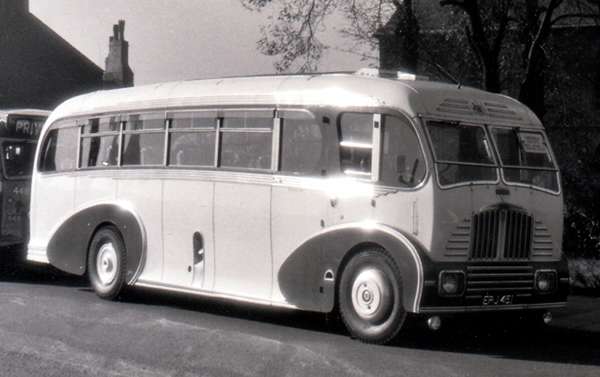
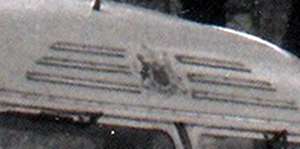
Just to clarify a number of queries above as to whether Salford's committee coaches carried the city coat of arms - both carried the coat of arms - this picture from an Omnibus Society outing of the previous coach ERJ 451 shows it clearly in the centre front above the windscreen.
Russ Jarvis
27/01/21 - 14:30
I was intrigued by the discussion on the Salford Weymann Fanfare 101 (TRJ 101), so I delved into the archives here at the Museum of Transport Greater Manchester. As you can see, 101 carried no crest on the sides but one was placed on the front; and the interior was very luxuriously appointed with just 26 seats, including a green baize card table at the rear for the use of Salford's diligent Councillors.
Paul Williams
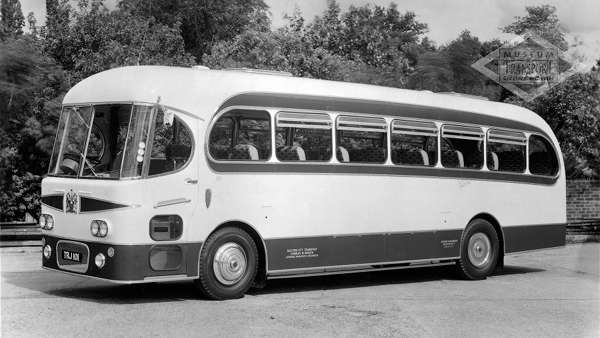
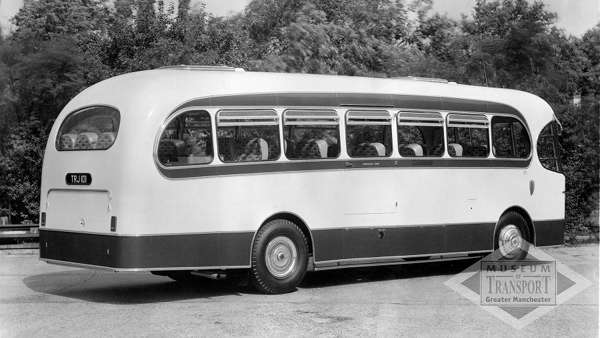
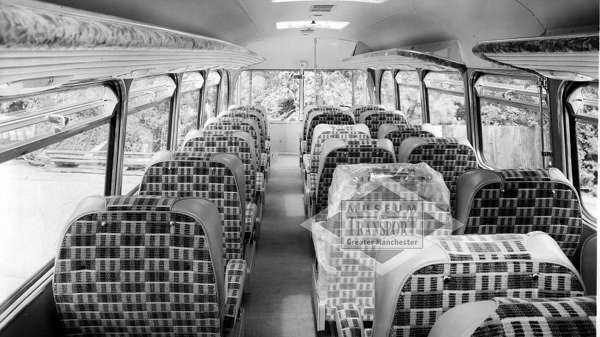
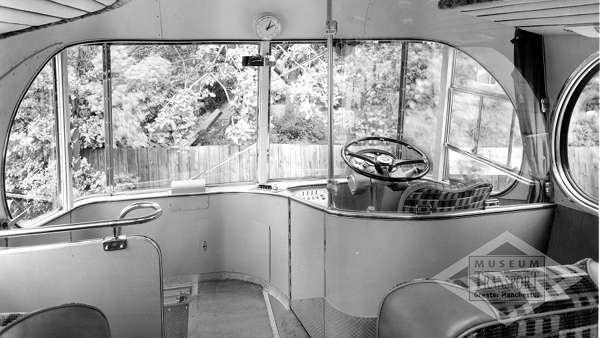
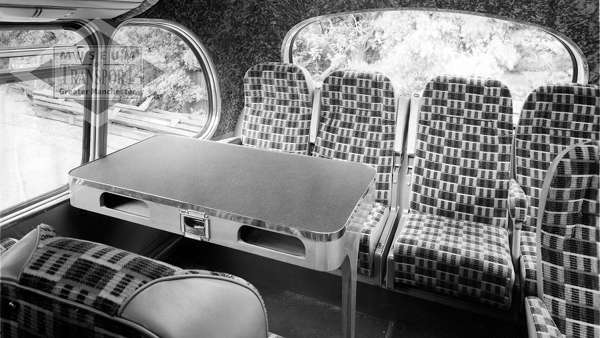
Comments regarding the above are more than welcome please get in touch via the 'Contact Page' or by email at obp-admin@nwframpton.com
If you have any bus related photographs that you would like to appear in a gallery on this website please send them to me by email at obp-admin@nwframpton.com
All rights to the design and layout of this website are reserved
Old Bus Photos from Saturday 25th April 2009 to Wednesday 3rd January 2024